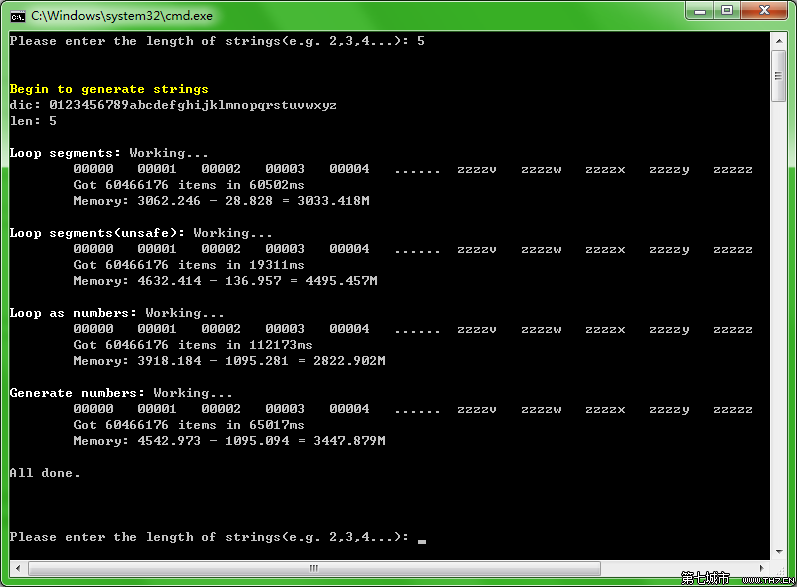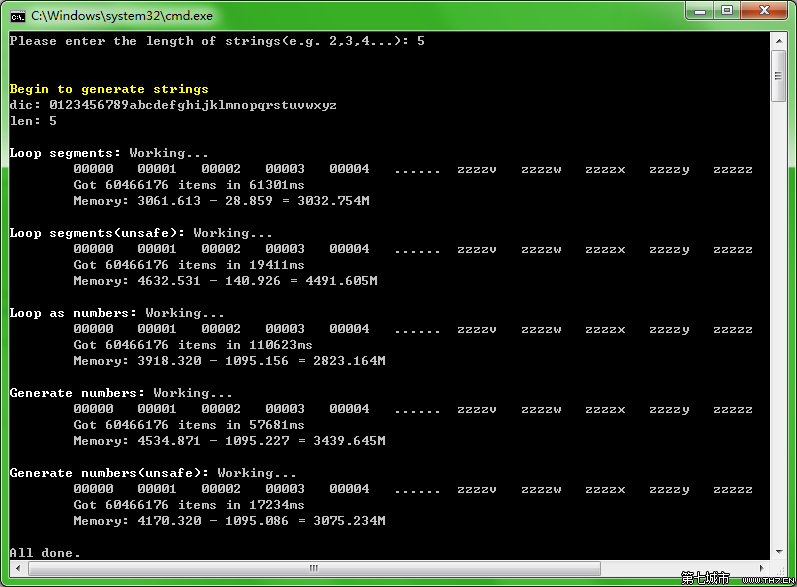
精通
英语
和
开源
,
擅长
开发
与
培训
,
胸怀四海
第一信赖
在C#代码中如果含有unsafe关键字,则该段代码就被标记为不安全代码。有时复制来的代码会出现“不安全代码只会在使用 /unsafe 编译的情况下出现”错误提示导致无法编译,这时就需要手动设置VS环境,让环境可以编译不安全代码
根据指定的字符集合(字典),按排列组合的规则(允许重复),生成指定长度的所有字符串。如下代码:
class Program{ static void Main(string[] args) { string dic = "abcdef";
int len = 3; int top_last_N = 5; IGenerator g = new Generator1();
var result = g.Generate(dic, len) ?? new List<string>();
Console.WriteLine("{0} strings generated:", result.Count); PrintTheResult(top_last_N, result);
Console.ReadKey(); } private static void PrintTheResult(int top_last_N, List<string> result)
{ if (result.Count > top_last_N * 2) { for (int i = 0;i < top_last_N;i++) { Console.WriteLine(result[i]); }
Console.WriteLine("......"); for (int i = result.Count - top_last_N;i < result.Count;i++) { Console.WriteLine(result[i]);
} }
else { foreach (var s in result) { Console.WriteLine(s);
} } }
}interface IGenerator{ List<string> Generate(string dic, int length);}
class Generator1 : IGenerator{ public List<string> Generate(string dic, int length)
{ // we should implement this method throw new NotImplementedException(); }}
举个例子,比如:字典为[a,b,c],指定长度为 2,则生成的所有字符串应当为:"aa","ab","ac","ba",……,"ca","cb","cc",总计9个字符串。那么程序里我们应当怎么来生成这些字符串呢?如下循序渐进地列出解决方案。
投石问路:假设长度固定
方案一:我们来多循环几次(循环拼接字符串)
方案二:不用字符串,使用不安全代码(循环拼接字符串Unsafe版)
方案三:换个角度看问题(字符串模拟数字依次循环进行进制转换)
方案四:小学的加法运算正闪闪发光(字符串模拟数字依次自增+1)
方案五:再次改写,不用字符串,使用不安全代码(字符串模拟数字依次自增+1的Unsafe版)
方案六:闲来没事(1):Fixed-point combinator
方案七:闲来没事(2):Fixed-point combinator + Unsafe 双剑合璧
命题中有三个关键要素:字典、长度、排列组合(允许重复)。
首先我们假定长度固定,比如长度为“3”,直接使用给定的字典进行排列组合就行了。
既然是排列组合,我首先想到的是循环,于是有:
class Generator1 : IGenerator{ public List<string> Generate(string dic, int length)
{ // since we deal with the "length" as a constant parameter, so we leave it alone. var result = new List<string>();
foreach (var x in dic) { foreach (var y in dic) { foreach (var z in dic) { result.Add(string.Format("{0}{1}{2}", x, y, z)); } } }
return result; }}
长度为3,那么我们用3个循环生成每一位的字符,然后拼凑起来,这简直太简单了,运行效果如下:

OK,好了,如果考虑长度为呢?长度直接关系到需要循环的次数,完了,我们的循环都是写死在代码里的,我们怎么知道传进来的长度参数值是多少,需要循环多少次啊?
说实在的,我觉得循环就是一个玩命却又任劳任怨的苦工。无论多么深、多么广、多么耗时的循环,他都能反反复复、机械地去执行,要么执行完成,要么累死——资源耗尽
对于上文中的 Generate 方法,我们需要根据参数来确定循环的次数,那么我们定义一个方法专门来做循环,然后根据参数的值来运行若干次。
仔细观察我们的第一次实现,除第一次循环之外,每一次的循环都是在之前循环得到的字符串基础上,追加一个字符,从而实现“拼凑”到足够长度的目的。那么第一次呢?其实第一次的循环就只是从依次从字典里取出每一个字符,放到结果集里,作为后续“拼凑”动作的种子。因此,首先,我们需要一个种子,循环在这个基础上进行,有了种子之后,就从种子的每一个元素上,发芽(分化)出第二次的“拼凑”...直到N次——看起来,这已经是一个树的生成了,只不过这个树比较特殊,每一个节点的分支数都一样。好了,见代码:
class Generator2LoopSegments :
IGenerator{ public List<string> Generate(string dic, int length) { List<string> result = null;
for (int i = 0;i <= length;i++) { result = Loop(dic, result);
} return result;
} private List<string> Loop(string dic, List<string> seed) { var result = new List<string>();
if (seed == null || seed.Count == 0) { // for the first time, we just choose one char only to fill full into the List.
// result.AddRange(from c in dic select c.ToString());
result.Add(string.Empty);
}
else { for (int i = 0;i < seed.Count;i++) { foreach (var c in dic) { result.Add(string.Format("{0}{1}", seed[i], c));
} } } return result; } public override string ToString() { return "Loop segments"; }}
好了,完美无瑕,实现了命题中要求的排列组合!不过,等等,咦,怎么当我 length 设为 5 的时候,竟然抛出 OutOfMemoryException 的异常了?内存占用很高啊!嗯,是不是因为编译成了 32 位程序的原因?改成 64 位试试?哈,行了,不过内存竟然占用了 3G!

Tips:
编译为32位程序,在64位Win7系统中运行,当内存占用接近2G时,程序即抛出 OutOfMemoryException 的异常,直接表现为无法创建字符串或无法向集合添加新项。
运行是能运行了,不过时间上貌似不尽人意,运行太久了,是不是还能有提高呢?怎么办呢?这里使用了大量字符串,对字符串的操作也非常多,要不咱不使用字符串,直接使用 char* 试试?
思路和上面的解决方案一致,只是对上面字符串相关的操作进行了修改,使用不安全代码 unsafe 。
class Generator2LoopSegmentsUnsafe :
IGenerator{ public unsafe List<string> Generate(string dic, int length)
{ char*[] result = null; for (int i = 0;i < length;i++) { result = Loop(dic, result); }
var list = new List<string>();
if (result != null) { foreach (var p in result) { var aa = new String(p); list.Add(aa); } }
return list; }
private unsafe char*[] Loop(string dic, char*[] seed)
{ char*[] result = null;
if (seed == null || seed.Length == 0) { result = new char*[dic.Length];
// for the first time, we just choose one char only to fill full into the List.
for (int i = 0;i < dic.Length;i++) { IntPtr p = Marshal.AllocHGlobal(sizeof(char)); result[i] = (char*)p.ToPointer();
*result[i] = dic[i];
// string will/should be end with the char '/0'. *(result[i] + 1) = '/0'; } }
else { result = new char*[seed.Length * dic.Length];
int n = 0;
for (int i = 0;i < seed.Length;i++) { foreach (var c in dic) { IntPtr p = Marshal.AllocHGlobal(sizeof(char));
result[n] = (char*)p.ToPointer(); *(result[n]) = *seed[i]; int j = 0;
// string will/should be end with the char '/0'. while (*(seed[i] + ++j) != '/0') { *(result[n] + j) = *(seed[i] + j); }
*(result[n] + j) = c;
// string will/should be end with the char '/0'. *(result[n] + j + 1) = '/0'; n++; } } }
return result; }
public override string ToString() { return "Loop segments(unsafe)"; }}
运行结果如下:

OK,从结果来看和上一个版本一致,不过时间和内存占用都不一样了!时间上少了很多,内存占用貌似不减反增,我猜想应当是因为 framework 中对字符串的处理比我手写得高端大气上档次一些吧……
到这里,看起来已经没太多的提升空间了,毕竟我们连这么高端的不安全代码都用了。果然是这样吗?唉,别忘记了基础的东西,这玩意的时间复杂度有点高啊?(O(N^3)?猜的。时间复杂度这玩意,我一直没怎么看过...如果不对,请不吝赐教....)嗯,能不能有个更简单的算法,让它的时间复杂度更低呢?
其实,如果细心你可能发现,这个排列组合,如果我们把字典换一下……比如 [0,1],长度 3,这将得到:000,001,010,011,100,101,110,111,比如 [0-9],长度 2,这将得到:00,01,02,03,04,…,97,98,99。我去~这是啥?这不就是连续的整数么?嗯,我们再看看,比如字典为 [0-9A-F],长度 2,这将得到:00,01,02,...,09,0A,0B,...,0F,10,11,...,1A,1B,...,1F,20,21,...,FD,FE,FF这,依然是连续整数,只不过是十六进制而已!说到这里,其实你已经看出来了,上面依次就是二进制,十进制和十六进制。当他们是这些情况时,我们想排列组合,那岂不是易如反掌?让数字递增加一,直接一个循环就输出搞定了!嗯,好办法,继续看,当字典为任意字符集的时候,可以吗?答案当然是可以的。[0-9A-F] 是十六进制,那 [0-9A-Z] 则自然是36进制!既然如此,那我们的“排列组合”算法,就成了进制转换的算法了,囧。
参考:http://baike.baidu.com/link?url=q_M-tOHBN0XtyvdHBv-sk8vuV8dJf-Yna-7nRp1xwYQP-m2pj9CHV0x-u0nbChAN。好吧,代码来了:
class Generator3LoopAsNumbers :
IGenerator{ public List<string> Generate(string dic, int length)
{ var fromBase = dic.Length; int min = 0, max = 0;
if (fromBase > 1) { max = (int)Math.Pow(fromBase, length) - 1; }
else { max = min; }
//Console.WriteLine("min = {0}, max = {1}", min, max);
var result = new List<string>();
for (var current = min;current <= max;current++) { var tmp = "";
for (var j = length - 1;j >= 0;j--) { var last = (int)(current % Math.Pow(fromBase, j + 1) / Math.Pow(fromBase, j));
tmp += dic[last]; } result.Add(tmp); }
return result; }
public override string ToString() { return "Loop as numbers"; }}
运行如图:

不过,好的想法不一定能运行出好的结果。按照这个解决方案,内存占用降了下来,但耗时却高了不少,将近第一个方案的两倍了,简直惨不忍睹!
正当我为之沮丧时,却突然又发现一丝曙光:既然我已经将这个排列组合看成是数字递增了,而且递增多少我也很清楚地知道,那为何我还要“劳心劳力”地去做进制转换呢?何不直接根据进制的规则,+1,+1,升位+1去做呢?小学加法啊!说改就改!
还记得小学时学的加法运算怎么算么?按小数点对齐,个位加个位,十位加十位,满10进一位。OK,按照这个思路再试一次看看,代码来了:
class Generator4GenerateNumbers :
IGenerator{ public List<string> Generate(string dic, int length)
{ var result = new List<string>();
string seed = new string(dic[0], length);
result.Add(seed);
while (GetNext(ref seed, seed.Length - 1, dic)) { result.Add(seed); }
return result; }
private bool GetNext(ref string seed, int idx, string dic)
{ if (idx < 0 || idx >= seed.Length) return false;
char c = seed[idx]; if (dic.IndexOf(c) < dic.Length - 1) { c = dic[dic.IndexOf(c) + 1];
seed = seed.Substring(0, idx) + c + seed.Substring(idx + 1, seed.Length - 1 - idx);
return true; }
else
{ c = dic[0]; seed = seed.Substring(0, idx) + c + seed.Substring(idx + 1, seed.Length - 1 - idx);
return GetNext(ref seed, idx - 1, dic); } }
public override string ToString() { return "Generate numbers"; }}
当然,可以从代码中看出来,我们这里的加法运算太简单了,简单到第二个因子是 1,也就是每次运算加法只是数字递增1而已。其中dic[0]表示了每位可能的最小的数,相应地,dic[dic.Length-1]表示了没位可能的最大的数。我们来运行试试:

成是成了,不过……这个结果依然有点惨!效率不高,内存占用仍然居高不下,看来这闪闪的光——要不是我还没发掘出来,那就是我眼花了?嗯……要不再改写成非安全代码试试?
照例,算法思路和上面一样,只是改写成非安全代码:
class Generator4GenerateNumbersUnsafe :
IGenerator{ public List<string> Generate(string dic,
int length) { var result = new List<string>();
unsafe { IntPtr p = Marshal.AllocHGlobal(sizeof(char));
var seed = (char*)p.ToPointer(); int i = 0;
for (;i < length;i++) { *(seed + i) = dic[0];
}
*(seed + i) = '/0'; do { result.Add(new string(seed)); }
while (GetNext(ref seed, length - 1, dic)); }
return result; }
private unsafe bool GetNext(ref char* seed, int idx, string dic)
{ int len = 0; for (;*(seed + len) != '/0';
len++) { }
if (idx < 0 || idx >= len) return false; char c = seed[idx];
if (dic.IndexOf(c) < dic.Length - 1) { c = dic[dic.IndexOf(c) + 1];
*(seed + idx) = c; return true; }
else { c = dic[0];
*(seed + idx) = c; return GetNext(ref seed, idx - 1, dic); } }
public override string ToString() { return "Generate numbers(unsafe)"; }}
哈,看起来效果不错哦,时间和空间的占用都有提升,并且效果比第二个方案还好!

时间消耗上,方案二和方案五不相上下,并且远低于其他方案,作为Unsafe升级版,也都差不多是原始版本的1/2;
内存消耗上,方案二的内存占用异常高,而同为Unsafe版本的方案五内存占用最低。